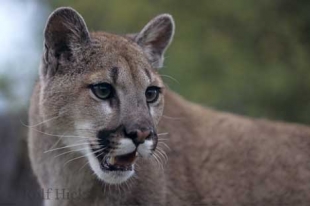Text by Jocie Ingram, Pictures by Rolf Hicker
Cougars are one of the most mysterious and secretive mammals of BC. Very few people will ever see a cougar, and despite all the media attention, attacks on humans are extremely rare. Bounties in the past resulted in the destruction of thousands of cougars. Today, concerns have been raised about protecting populations of these impressive mammals.

Cougars (Felis concolor), also known as mountain lions, are sleek and powerful predators at the top of the food chain. An adult male typically weighs 125 lbs, and a female 100 lbs. From tip to tail, cougars are 1.7-2.5 metres long; the long, cylindrical tail makes up one-third of this length. Cougars have short fur that may be reddish-brown to grey-brown, with lighter under parts and a darker tail tip. Young kittens have spotting and ringed tails, which disappear as they reach adulthood.
With a long, lithe body, cougars, like house cats, have proportionally smaller heads and ears. Cougars' feet have five toes in front and four toes behind. Muscular hind legs enable the cougar to jump 9 metres forward in one bound, or 5.5 metres straight up. Armed for hunting, cougars have long retractable claws and razor-sharp canine teeth.
Cougars primarily prey upon deer, but may attack whatever is available, including small mammals and birds, or larger mammals like elk. They silently stalk prey from a distance of 6-15 metres and attack from behind with a few rapid jumps, targeting the back of the neck. After a kill, they bury what is left over under soil and leaves, and return to this food cache in subsequent days. Cougars are most active at dawn and dusk, but may hunt at any time of day and in any season.
Territories of male cougars vary from 150-1000 square km, and females from 65-500 square km. Occupied ranges are clearly marked by scratch piles where cougars leave scent and scat. Cougars are solitary, with the exception of females with kittens.

Male cougars are polygamous (one male breeds with several females), and do not care for young. Females are monogamous, and are fertile year round. After a 90-day gestation period a litter of one to four kittens is born. Kittens can open their eyes after 10-14 days, and are able to start eating meat around 6 weeks of age. In spring, one and two year old cougars become independent of their mothers, and may roam widely to find a new territory. Life expectancy for cougars in the wild is 10-12 years.
Cougars are found only in the Western Hemisphere, from BC south to Argentina. In Canada, they are found as far east as New Brunswick. Most cougars in BC occupy the southern one-third of the province and the islands along the coast, with the exception of the Queen Charlotte Islands.
In the past, cougars were unfortunately regarded as a nuisance species that posed a threat to humans and livestock. The BC government put a bounty on cougars, paying $20 - $50 per cougar. Cecil "Cougar" Smith, who came to Comox in 1887, made a career of killing cougars, which were chased up trees by specially trained hounds. Among others, Campbell River's nature writer Roderick Haig-Brown financed his early writing efforts by collecting cougar bounties. The BC bounty ended in 1958, after which some former bounty hunters, such as ?Cougarman" Percy Dewar, had a change of heart and became active in cougar conservation efforts.
Cougar attacks on humans seldom occur, as cougars are reclusive animals that do not seek out humans. However, a starving and desperate cougar will attack humans, dogs and livestock. Like all wild animals, cougars sometimes behave unpredictably, and can be very dangerous. Cougars tend to attack children because their high-pitched voices, erratic movements and small size identify them as prey.
Between 1896-1996 there were 29 non-fatal, and 5 fatal cougar attacks in BC. Of these 20 of the non-fatal and 4 of the fatal attacks were on Vancouver Island. Most of the attacks were on kids under the age of 16.
Precautions can be taken to avoid confrontations with cougars. Being in a group and making lots of noise is a good deterrent. Hikers can carry a sturdy walking stick and keep an eye out for cougar tracks and sign. Avoid dawn and dusk, when cougars are most active. Children and pets should be kept close at hand and under control.
Cougars and humans can co-exist, and hopefully these beautiful mammals will never again need to be culled from our province. Through awareness and education, confrontations can be kept to a minimum.
Cougar Safety Tips:
- Never approach a cougar.
- Stay calm and talk in a confidant voice.
- Pick up children and hold them close.
- Do not run or turn your back. Back away slowly.
- If a cougar is threatening enlarge your image, wave sticks and branches and make noise.
- If a cougar attacks fight back with anything available and speak loudly and firmly.
Related links for the cougar animal:




